When my horse’s back is swinging, it is supple and loose and he carries me into his gaits with a swinging rhythm. I’m not sitting on my horse; rather, he allows me to sit into him and into his rhythm.

When a horse’s back is not yet supple and loose, the rider feels that she’s being thrown out of the saddle. It’s difficult to sit and the rider can’t swing in the rhythm of the horse. In that case, the hind legs work separately from the middle of the horse and the contact. Sometimes I ride a horse who isn’t using his back and hasn’t had correct basics. Then I must work the hind legs to send the energy through his back to the bit. In that way, the horse’s back becomes the connection between his hind legs and his mouth. I must always feel that connection.
Defining Submission. A submissive horse is one who is supple, loose, happy and reacting on my aids. The whole horse swings, so it’s easy to get into his rhythm. The horse’s paces go from the hind legs toward the bit, and he carries me. Mentally, my horse is relaxed, but he concentrates on me and waits to see what I want him to do. He enjoys the work so he is willing. When my horse is submissive, he is not separate from me. We are one being.
—From “The Submissive Horse,” by Helen Langehanenberg with Beth Baumert,
Dressage Today, June 2010.
Working with a Swinging Back is Easier
When the horse works from the hind legs through his back to the bit, he uses his whole body. So each individual part of the horse has less work to do, which makes the job much easier. On the other hand, when the horse’s legs are working under a stiff back, that back cannot take work from the legs, so the legs must work harder. The more the horse is supple and loose, the more he can use his whole body. And the more he uses his whole body, the easier the work.
Developing the swinging back begins with submission. Without submission you will not have a situation in which the whole horse moves together. The submissive horse is supple inside and outside. The horse’s body parts all work together and his mind is supple as well.
Transitions to Develop Submission and a Swinging Back
I try to achieve submission and a swinging back with transitions. These transitions develop obedience, change the horse’s body position and start to get the horse working between my aids.
Downward Transitions: Trot to Walk. The transition from trot to walk is a downward transition, but I want to do it in a forward way, keeping the hind legs sending energy through the back to the mouth. I achieve this by riding forward into smaller and smaller trot steps. The back keeps swinging because I don’t slow down. In fact, as my horse shortens his strides, the shape of his body also changes and closes, so it’s easier for him to use his whole body with a swinging back.
Try this: Track right on a 20-meter circle in either working or collected trot. On half of this circle, ask for smaller, smaller, smaller trot steps. Then go back to the normal working or collected trot on the other half-circle. Try it tracking left also. When you are successful in shortening the strides, you may decide to ask for walk or you may decide to stay in trot. If you play with making the trot smaller but sometimes not going to walk, the horse learns to wait for your aids in the training. You, the rider, should make the decision of whether or not to finish the transition. If your horse learns to listen for your aids, he won’t, for example, decide to halt at X on his own. In the end, you need to do transitions at a special point in every test so you have to train your horse to listen and wait for your aids to change the gait.
Upward Transitions: Walk to Trot. The transition from walk to trot is an upward transition and most horses are inclined to make a big step in the first stride of trot. Then they often lose the swinging back because they become too long in the frame and disengaged in the hindquarters. To avoid this when you ask for trot, start with small steps and then make them bigger step by step so the whole body keeps working and your horse’s back keeps the connection between the hind legs and the mouth. The hind legs must keep sending the energy through the back to the bit.
Trot–Canter–Trot Transitions. When you do trot–canter–trot transitions, you can use the same ideas. In the downward transition, try to shorten the canter strides and teach your horse to do the downward transition to trot on your aids. Some horses, especially at higher levels, have difficulty with canter–trot transitions. Although the transition isn’t actually difficult, the horse who is trained to do pirouette canter might think he should collect the canter more instead of transitioning to trot. In the upward transition to canter, try to make the first stride a small one so your horse doesn’t sprawl and become disengaged.
Transitions within the gaits. Transitions within the gaits develop swing in the back, too. Try this: Begin tracking right on a 20-meter circle. Play with making the strides longer and shorter:
• Go from collected trot to working trot and back to collected trot.
• Within the collected trot, ask for more collected strides and then more forward collected strides.
• Go from collected trot to medium trot and back to collected trot.
• If your horse is able, do transitions between passage and collected trot.
Keep the feeling that your horse’s energy goes through his whole body so the hind legs keep working through the back to the mouth.
The transition from trot to walk is a downward transition, but do it in a forward way by shortening the strides. If you play with making the trot smaller and sometimes not going to walk, the horse learns to wait for your aids. You, the rider, should make the decision of whether or not to stop so your horse learns to listen. When you ask for the upward transition to trot, start with small steps and then make them bigger step by step so your horse’s whole body keeps working and his back keeps the connection between the hind legs and the mouth.
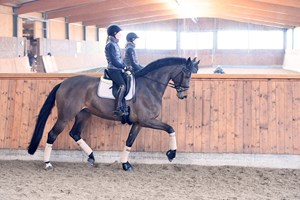
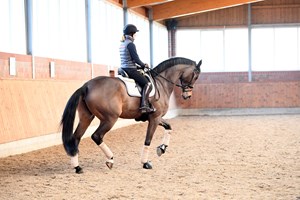

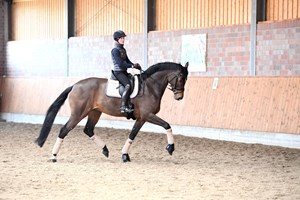
In the downward transition from canter to trot, try to shorten the canter strides and teach your horse to do the downward transition to trot on the aids. Some horses, especially at higher levels, have difficulty with canter–trot transitions. Although it’s not really difficult, when the horse is trained to go to pirouette canter, he might think he should collect the canter more instead of transitioning to trot. In the upward transition to canter, try to make the first stride a small one so your horse doesn’t sprawl and become disengaged.
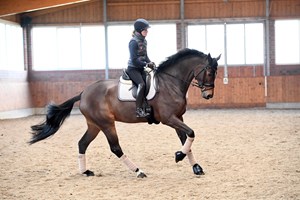

How to Shorten and Lengthen the Stride
The rider shortens and lengthens the stride with the weight aids—the seat. Then, as the seat becomes more and more effective, you will need fewer and fewer rein aids. First, ask your horse to let you sit into his back. If the horse’s back is not really supple, try to sit in more to tell him, “Don’t throw me out of the saddle.”
To shorten the stride:
• Use your leg aids to tell your horse to go forward into shorter strides. When you sit in and use your leg, it makes your horse’s back swing more up and down. Then you have more influence and your horse is able to react directly to your aids.
• Sit heavier and make your seat move slower, which will help you bring your horse together. When he becomes more connected, the back can be more supple.
• You need your rein aids to send the energy back to the hind legs where the circle of energy begins again.
To lengthen the stride:
Give the reins a bit so the horse is free to go into longer strides. Again, remember that you need the leg aid, but he mustn’t go forward in a hurry. It helps for the rider to think of collecting when asking for lengthening and think of going forward when asking for shorter strides.
To shorten and lengthen the strides, you need all the aids together but sometimes more of one than another.
• You need your leg aids to make your horse’s hindquarters active so they can send the energy through the back and to the mouth.
• You need your weight aid (the seat) to work the swinging back.
• You need your rein aids to send the energy back to the hind legs where the circle of energy begins again.
Although you want soft rein aids, the contact has to be sufficient to send the energy back to the engaged hind legs so they can carry more weight and then push forward through the back to the mouth again and again.
Transitions between collected trot and medium trot develop the swinging back.
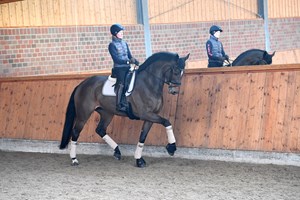

If your horse is able, do transitions between passage and collected trot to develop the swinging back.

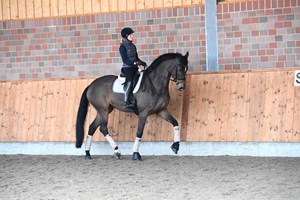
The Consequent Rider Expects Obedience
Horses trust a rider who is “consequent.” That is, the rider who expects a consequence from her aids is easiest for the horse to understand. We, as human beings, cannot do everything we want in our lives, and it’s the same for the horse. We have rules in our lives and if we agree to those rules, we have an easy, uncomplicated life. It should be the same for the horse. Some things are okay and some are not.
As trainers, we need to be consequent on two levels:
1. Expectations in behavior: Horses are large, and if they are not on our side, they can be dangerous, so we need to have basic communication and an expectation of obedience even on the ground. Horses must understand yes and no.
2. Expectations in training: The rider who is consequent as a trainer works in a very straightforward way. I often say to my students, “Don’t let the horse know if you are unsure or if you don’t know what to do or how to do it. Don’t be afraid to make a mistake.” Sometimes it’s better to make a mistake because you can learn from that. If you are too careful and do nothing, your horse must guess what you want. Horses are happy and react well when they have clear instructions.
An Attitude of Play
Although you must have submission and a swinging back, you also want to have fun and you want your horse to have fun. You also want the work to be as easy as possible. Try to teach your horse by explaining how to move in the easiest way. When the work is easy, the horse likes to do it. It’s the same with us: We like to do that which is easy and we avoid that which is difficult. When your horse has understood you, the work gets easier and is, therefore, more fun.
Start and Finish with the Basics
When your horse has proper basics, he is able to do correct transitions on the aids and work through his swinging back toward the mouth in a supple, straight way. With the basics mastered, your horse will learn quicker, his work will be physically and mentally easier, he will get the right feeling in his body and will have the right reactions to your aids.
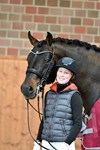
Helen Langehanenberg has trained with Ingrid Klimke and Klaus Balkenhol. A member of the A-squad of German dressage riders, she competed Damon Hill NRW in the team competition at the 2011 European Championships and at the World Cup™ Final in 2012, where she placed second. The pair also represented Germany at the 2012 London Olympic Games, where the German team won the silver medal, won the 2013 World Cup Final in Sweden and took part in the World Equestrian Games in France, where they placed second in the two individual competitions. Helen currently trains out of her farm in Billerbeck, Germany.











